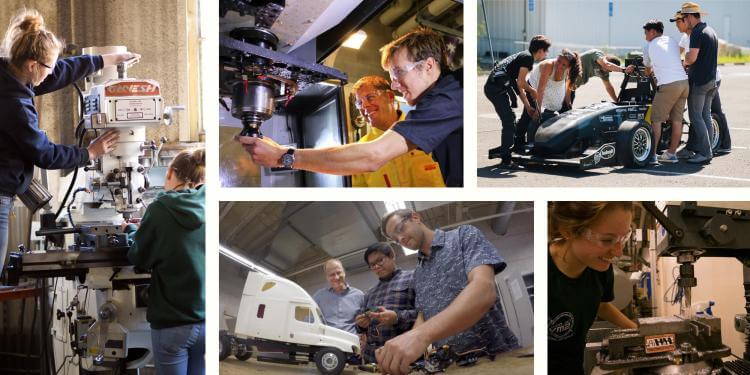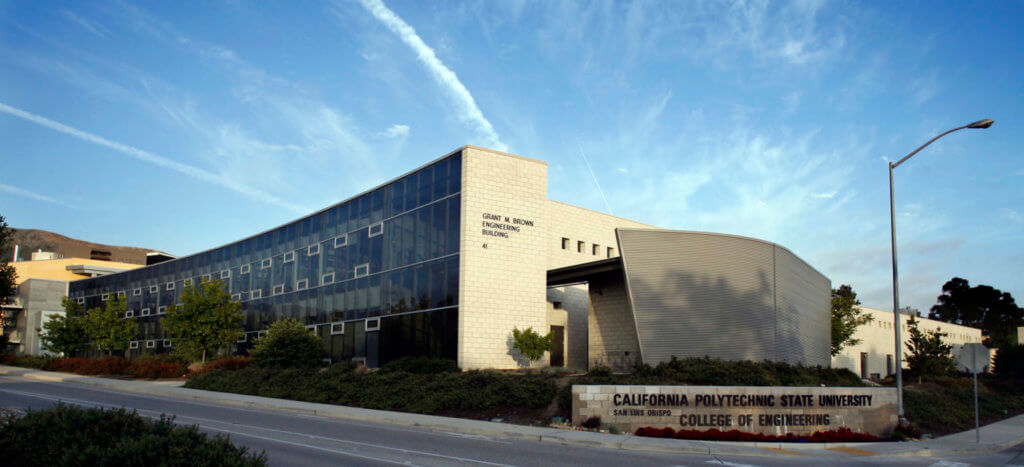about

Learn by Doing
Mechanical engineering is the largest department at Cal Poly with more than 1,250 undergraduates and is ranked as the second-best undergraduate focused mechanical engineering program in the country by U.S. News and World Reports.
Our curriculum shares a common philosophy that real engineering work requires not only a solid understanding of theory but also hands-on experiences and skills to finish the job. Our program effectively combines theory and practical application to prepare students for careers in a wide variety of industries and graduate school.
Our state-of-the-art laboratories, student clubs and organizations, and machine shops are integral parts of our curriculum and give students unique Learn by Doing opportunities to become successful and resourceful professionals in their fields.
Mission and Vision
Our Mission
To empower graduates with ethical and technical skills, fully prepared to contribute to industry, government, and academia. We prepare individuals for responsible practice in the art and science of mechanical engineering through a comprehensive undergraduate curriculum that emphasizes hands-on, collaborative experiences and embodies a Learn-By-Doing philosophy.


Diversity Vision
The mechanical engineering department at Cal Poly envisions inclusive and equitable environments in all our offices, classrooms, laboratories and shops. We embrace individual differences and leverage diversity to promote deep engineering learning for all students.
Goals:
- Increase awareness of issues facing diverse groups, especially as they relate to mechanical engineering education and practice.
- Create spaces for discussions of issues related to diversity, equity, bias, power, discrimination, and other systems of oppression.
- Promote the creation of inclusive environments through implementation of departmental policies and procedures.
- Facilitate initiatives to increase diversity within the department.
The BS degree program in Mechanical Engineering is accredited by the Engineering Accreditation Commission of ABET, https://www.abet.org, under the General Criteria and the Mechanical and Similarly Named Engineering Programs Program Criteria.
Program Educational Objectives
To satisfy the mission of the mechanical engineering program, the alumni from this program will:
Research, design, develop, test, evaluate, innovate, or implement engineering solutions to problems that are of a complexity encountered in professional practice.
Communicate and perform as an effective engineering professional in both individual and team-based project environments.
Recognize and evaluate the ethical implications and societal impacts of engineering solutions.
Continuously improve through lifelong learning.
These are the expected career accomplishments of our alumni three to five years after graduation.
Student Outcomes
In order to prepare our alumni for their career accomplishments expressed by the Program Educational Objectives, the students in the program will be proficient in the following skills upon graduation:
Criterion 3(1): An ability to identify, formulate, and solve complex engineering problems by applying principles of engineering, science and mathematics.
The student will be able to apply basic math and science principles and associated analysis techniques.
The student will be able to evaluate components, systems, and processes and be able to develop appropriate models of engineering systems.
The student will be able to analyze their models, interpret their results, and formulate appropriate action.
Criterion 3(2): An ability to apply engineering design to produce solutions that meet specified needs with consideration of public health, safety, and welfare, as well as global, cultural, social, environmental, and economic factors.
The student will be able to recognize a need, identify constraints, and develop appropriate design specifications.
Using the above specifications, the student will be able to synthesize conceptual solutions for a component, system, or process.
The student will be able to use analysis techniques to refine and select the design of a component, system, or process.
The student will be able to build a functional prototype and assess if it meets design specifications.
Criterion 3(3): An ability to communicate effectively with a range of audiences.
The student will be able to write an effective memorandum, letter, abstract, and project report for a wide range of audiences.
The student will be able to give a coherent and effective oral presentation for a wide range of audiences.
The student will be able to critique writing samples and oral presentations and identify both strong points and weak points in grammar, clarity, and organization.
Criterion 3(4): An ability to recognize ethical and professional responsibilities in engineering situations and make informed judgments, which must consider the impact of engineering solutions in global, economic, environmental, and societal contexts.
The student will be able to interpret engineering professional codes of ethics and to identify situations with ethical concerns.
The student will be able to identify and mitigate health and safety concerns associated with their design.
The student will be able to assess the environmental, societal, and economic impact of their engineering solutions.
Criterion 3(5): An ability to function effectively on a team whose members together provide leadership, create a collaborative environment, establish goals, plan tasks, and meet objectives.
The student will be able to manage a team project by establishing goals, planning tasks, and meeting objectives.
The student will be able to collaborate effectively on a team and contribute to an inclusive teamwork environment.
The student will be able to identify when problems occur due to poor interactions among team members and identify ways to improve team dynamics.
Criterion 3(6): An ability to develop and conduct appropriate experimentation, analyze and interpret data, and use engineering judgment to draw conclusions.
The student will be able to select and operate appropriate instrumentation used in engineering measurement.
The student will be able to design and conduct an experiment and compare the results to those predicted by an analytical model.
The student will be able to interpret and draw conclusions from the results.
Criterion 3(7): An ability to acquire and apply new knowledge as needed, using appropriate learning strategies.
The student will be able to recognize the limitations of their knowledge and to acquire new knowledge using appropriate learning strategies.
The student will be able to find and use appropriate technical resources.
The student will be able to identify their need for additional learning.
ME 128-Introduction to Mechanical Engineering I (PDF)
ME 129-Introduction to Mechanical Engineering II (PDF)
ME 130-Introduction to Mechanical Engineering III (PDF)
ME 161-Introduction to Composite Materials Manufacturing (PDF)
ME 163-Freshmen Orientation to Mechanical Engineering (PDF)
ME 211-Engineering Statics (PDF)
ME 212-Engineering Dynamics (PDF)
ME 228-Engineering Design Communication (PDF)
ME 234-Philosophy of Design (PDF)
ME 236-Engineering Measurement and Data Analysis (PDF)
ME 251-Introduction to Detailed Design with Solid Modeling (PDF)
ME 263-Introduction to Mechanical Engineering For Transfer Students (PDF)
ME 264-Introduction to Mechanical Engineering For Transfer Students (PDF)
ME 302-Thermodynamics I (PDF)
ME 303-Thermodynamics II (PDF)
ME 305-Mechatronics (PDF)
ME 318-Mechanical Vibrations (PDF)
ME 322-Introduction to System Dynamics (PDF)
ME 326-Intermediate Dynamics (PDF)
ME 328-Design for Strength and Stiffness (PDF)
ME 329-Mechanical Systems Design (PDF)
ME 341-Fluid Mechanics I (PDF)
ME 343-Heat Transfer (PDF)
ME 347-Fluid Mechanics II (PDF)
ME 359-Fundamentals of HVAC Systems (PDF)
ME 401-Stress Analysis (PDF)
ME 402-Orthopedic Biomechanics (PDF)
ME 404-Applied Finite Element Analysis (PDF)
ME 405-Mechatronics (PDF)
ME 409-Interdisciplinary Study in Biomechanics (PDF)
ME 410-Experimental Methods in Mechanical Design I (PDF)
ME 412-Composite Materials Analysis and Design (PDF)
ME 415-Energy Conversion (PDF)
ME 416-Ground Vehicle Dynamics and Design (PDF)
ME 422-Mechanical Control Systems (PDF)
ME 423-Robotics-Fundamentals and Applications (PDF)
ME 428-ME 429 ME 430-Senior Project (PDF)
ME 435-Drilling Engineering (PDF)
ME 437-Nuclear Energy Power Generation (PDF)
ME 438-Nuclear Power Plant Design (PDF)
ME 439 Nuclear Power Plant Operations (PDF)
ME 441-Single Track Vehicle Design (PDF)
ME 442-Design of Machinery (PDF)
ME 443-Turbomachinery (PDF)
ME 444-Combustion Engine Design (PDF)
ME 448-Thermal System Design (PDF)
ME 450-Solar Power Systems (PDF)
ME 453-Trends and Opportunities in HVAC&R (PDF)
ME 454-Benchmarking and Assessment of Building Energy Performance (PDF)
ME 455-Introduction to Building Energy Modeling (PDF)
ME 456-HVAC Air and Water Distribution System Design (PDF)
ME 457-Refrigeration Principles and Design (PDF)
ME 458-Building Heating and Cooling Loads (PDF)
